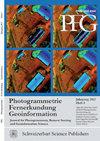Image analysis methods to monitor natura 2000 habitats at regional scales - the ms. monina state service example in schleswig-holstein, Germany
Q Social Sciences
引用次数: 6
Abstract
Summary: The Natura 2000 network of protected sites is one of the means to address the issue of biodiversity conservation in Europe. Protected under the habitat directive, EU member states have to undertake surveillance of habitats and species of community interest and report every six years on habitat range and distribution, conservation status and the future prospects of the habitats within and outside of protected sites. Remote sensing techniques have been applied successfully to monitor habitat changes relevant for Natura 2000 monitoring using multioral satellite image data, but many challenges remain especially outside protected sites to assess the development of habitats over time. A flexible information layer concept was developed within the FP7 project MS.MONINA to address the complex task of monitoring natural habitats. In this paper the new approach to classify grassland land cover classes in Schleswig-Holstein, Germany, will be presented. Based on ecological parameters experts defined simple description models, which were used by image analysts to extract corresponding image features for four different grassland types. Information layer operators were defined to extract image features for subsequent classifications. (Less)区域尺度上监测2000年自然栖息地的图像分析方法——以德国石勒苏益格-荷尔斯泰因的ms. monina州服务为例
摘要:Natura 2000保护地点网络是解决欧洲生物多样性保护问题的手段之一。受《栖息地指令》保护,欧盟成员国必须对具有社区利益的栖息地和物种进行监测,并每六年报告一次栖息地范围和分布、保护状况以及保护区内外栖息地的未来前景。遥感技术已成功地应用于监测与利用多口卫星图像数据监测Natura 2000有关的生境变化,但仍然存在许多挑战,特别是在受保护地点之外评估生境的长期发展。FP7项目MS.MONINA开发了一个灵活的信息层概念,以解决监测自然栖息地的复杂任务。本文介绍了德国石勒苏益格-荷尔斯泰因地区草地覆被分类的新方法。专家根据生态参数定义了简单的描述模型,图像分析人员使用该模型提取了四种不同草地类型的相应图像特征。定义信息层算子提取图像特征,用于后续分类。(少)
本文章由计算机程序翻译,如有差异,请以英文原文为准。
求助全文
约1分钟内获得全文
求助全文
来源期刊

Photogrammetrie Fernerkundung Geoinformation
REMOTE SENSING-IMAGING SCIENCE & PHOTOGRAPHIC TECHNOLOGY
CiteScore
1.36
自引率
0.00%
发文量
0
审稿时长
>12 weeks
 求助内容:
求助内容: 应助结果提醒方式:
应助结果提醒方式:


